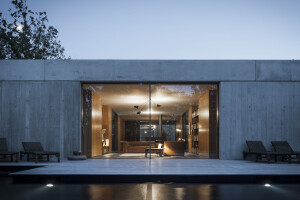It is a corporate office project for a company that provides human and logistical capital to oil platforms in Ciudad del Carmen, Mexico. During our research, we discovered the enormous cultural, historical, and architectural strength of Campeche. Very important archaeological sites for the Mayan civilization make this place a very important location: Calakmul; the church of Guadalupe, where Hernan Cortez’s grandson was baptized; the exploitation of Palo de Tinte by British pirates for the Spanish monarchy; the discovery of a huge shrimp bank; several oil deposits; the influence of French architecture on the island; the Mayan language; among many other elements.

It seemed necessary for this project to convey through architecture the features of a native culture. The first and most important of them was the oculus, or solar observatory: a circular extraction of our slab that functions as a transept in our project’s cruciform plan. It not only organized and gave direction to all circulations, but also allowed us to have a view of the sky and the stars as the ancient Mayans did in their observatories. This was reinforced by the reflection of the sky itself on a thin layer of water, thus forcing an encounter with the ancient god.

The second evocation were the staggered esplanades that referred to the sacred Mayan city of Calakmul. A cross section denotes more blatantly the pyramidal vocation of the project and how the different platforms of the project are articulated through such long staircases.

The last and perhaps most obvious is a clear reference to the Mayan civilization: a truncated pyramid-shaped element that receives pedestrian and vehicular traffic and controls access. The cruciform project is organized from a long circulation axis, interrupted by the water mirror. From there, the program splits into two main areas: the executive area in the left arm of the cross and the operative area in the right one. This was due to an unexpected request from the client to keep both areas well differentiated. The public areas are placed at the far end of the site: a tree-lined plaza, a classroom or conference room, dining rooms, restrooms, and a psychological care area.

The function of the project is inspired by the way Alberto Campo Baeza solved an assignment given by the Advisory Council of Castilla y Leon, Spain. Alberto, like us, encountered a rather irregular and difficult polygon; to organize it, he fit a platonic element at the most convenient end of the terrain and turned it into an organizing element around which peripheral patios dance, surrounding the new construction and providing it with a controlled and inspiring atmosphere.










































